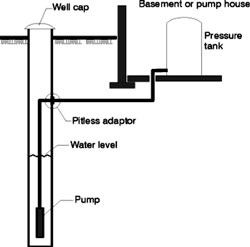HABITAT
Well, Well, Well: How to Install Them and Save on Water Bills
Robin L. Barton in Building Operations
Brigham Park Section IV, between Sheepshead Bay and Marine Park in Brooklyn is made up of 324 units across six buildings. A few years ago, says Lewis Kobak, Brigham Park's general manager and former longtime board president, drought conditions forced the city to restrict water use in the spring and summer, which endangered the co-op's valuable landscaping. At Hilltop Village Co-op No. 4 in Holliswood, Queens, the three-building, 296-unit co-op had also spent "thousands of dollars on landscaping," says Marc Haken, board president for the last 27 years. But because of water-use restrictions, some of Hilltop's landscaping had died.
Both co-ops wanted an alternative to using city water. The only option: wells. Brigham Park installed six, one in each building's basement. Hilltop Village installed two exterior wells. Both co-ops connected their wells to in-ground sprinkler systems installed concurrently, and while both now use well water for landscaping, Hilltop also connected its wells to its laundry rooms and uses well water in its washing machines.
Neither Kobak nor Haken had any trouble convincing their boards; Kobak describes the project as "almost a no-brainer," while Haken says it took him about "a minute and a half" to convince the rest of the board to install wells. Both co-ops had money in their reserve funds to pay for this capital expense, so no assessments and maintenance increases were needed. Installation took little time and caused no disruptions. Kobak says that it took about three days to install each well.
Down to the Waterline
At Brigham Park, a landscaping company drilled small holes big enough for a pipe in the basement of each building. The hole has to be deep enough to reach the water table, so the higher the table, the easier the job. The company also installed pumps, and tested the well water to ensure it was suitable for landscaping. It was easy to find space in each basement, says Kobak, because the wells take up little room and posed no structural concerns.
At Hilltop Village, holes were drilled in the middle of grassy areas. Drilling was a challenge because, as its name suggests, the co-op is on a hill, so the well company had to drill down about 800 feet. Then, a pump was installed at the bottom of each well. Finally, says Haken, the wells were connected to the laundry rooms, to an in-ground sprinkler system and to spigots throughout the property to which hoses can be attached. The process took about two weeks.
Kobak says it cost Brigham Park about $2,500 per well, while Haken says Hilltop's more complicated wells were about $10,000 each. The co-ops also had to pay $300 for each well's permit, plus $15 a year to renew. The city allows wells in all five boroughs; See the New York City Department of Heath of Mental Hygiene page "Permit Type 33 - Use of Well Water For Other Than Drinking" for more information on permit requirements. Note: The city won't allow the well water to be used for drinking or bathing; at Hilltop the spigots are specifically labeled, "Well water: don't drink."
The wells need maintenance two to three times a year. The biggest issue is changing the pump filters at the start of the season. Because Hilltop Village's wells are outdoors, they're used only from April through October, so the co-op pays its sprinkler company to turn the wells on and off each year. The sprinkler company also switches the laundry rooms to city water when the wells are off. Haken says the company fee is less than $1,000.
Brigham Park's wells have paid for themselves already, says Kobak, who was told the co-op could expect to save about 15 percent on water bills. CPA Robert A. Mellina of Zeidman, Lackowitz, Prisand & Co., which handles Brigham Park's accounting, estimates that about half of the co-op's $20,000 annual savings "was probably attributable to the wells."
Likewise, a delighted Haken says Hilltop Village's water bills for the summer months are now the same as those for the winter months. The co-op has also saved money by not having to replace landscaping that died from lack of water. Well water hasn't harmed shareholders' clothes or the co-op's washing machines. The only downside Kobak sees is that Brigham Park's mineral-filled well water can leave rust-colored stains on the sidewalks, though a power wash easily removes these stains. (Hilltop Village doesn't have this problem because its water, like the city water in Queens, comes from a Long Island aquifer.)
What about the co-ops' landscaping — the main reason for installing the wells? Haken says Hilltop Village's landscaping is doing just fine. And Kobak notes that Brigham Park's is doing "unbelievably well" and has "never looked so good."
Adapted from Habitat March 2007. For the complete article and more, join our Archive >>




